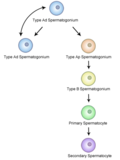Spermatogonium
(Redirected from Spermatogonia)
Spermatogonium (plural: spermatogonia) is a type of germ cell that is found in the testis. It is the earliest stage in the process of spermatogenesis, which is the production of spermatozoa or sperm cells.
Overview
Spermatogonia are located in the outermost layer of the seminiferous tubules, which are the site of sperm production in the testes. They are diploid cells, meaning they contain two sets of chromosomes.
Types of Spermatogonia
There are three types of spermatogonia: Type A dark (Ad), Type A pale (Ap), and Type B.
- Type A dark (Ad) spermatogonia are reserve cells. They do not usually undergo cell division, but they can be called upon to produce more spermatogonia if needed.
- Type A pale (Ap) spermatogonia are proliferative cells. They undergo regular cycles of cell division to produce more spermatogonia.
- Type B spermatogonia are transitional cells. They divide to produce primary spermatocytes, which are the next stage in spermatogenesis.
Spermatogenesis
Spermatogenesis is the process by which spermatogonia develop into mature spermatozoa. This process involves several stages:
- Mitosis of spermatogonia: The spermatogonia undergo mitosis, a type of cell division that results in two identical daughter cells. This allows the population of spermatogonia to be replenished.
- Meiosis of spermatocytes: The primary spermatocytes produced by the Type B spermatogonia undergo meiosis, a type of cell division that results in four daughter cells, each with half the number of chromosomes of the parent cell. This produces haploid cells, which are necessary for sexual reproduction.
- Spermiogenesis: The haploid cells produced by meiosis, called spermatids, undergo a process of maturation called spermiogenesis to become mature spermatozoa.
Clinical Significance
Abnormalities in the spermatogonia or in the process of spermatogenesis can lead to infertility in males. For example, some forms of testicular cancer can originate from spermatogonia.
Transform your life with W8MD's budget GLP-1 injections from $125.
W8MD offers a medical weight loss program to lose weight in Philadelphia. Our physician-supervised medical weight loss provides:
- Most insurances accepted or discounted self-pay rates. We will obtain insurance prior authorizations if needed.
- Generic GLP1 weight loss injections from $125 for the starting dose.
- Also offer prescription weight loss medications including Phentermine, Qsymia, Diethylpropion, Contrave etc.
NYC weight loss doctor appointments
Start your NYC weight loss journey today at our NYC medical weight loss and Philadelphia medical weight loss clinics.
- Call 718-946-5500 to lose weight in NYC or for medical weight loss in Philadelphia 215-676-2334.
- Tags:NYC medical weight loss, Philadelphia lose weight Zepbound NYC, Budget GLP1 weight loss injections, Wegovy Philadelphia, Wegovy NYC, Philadelphia medical weight loss, Brookly weight loss and Wegovy NYC
|
WikiMD's Wellness Encyclopedia |
| Let Food Be Thy Medicine Medicine Thy Food - Hippocrates |
Medical Disclaimer: WikiMD is not a substitute for professional medical advice. The information on WikiMD is provided as an information resource only, may be incorrect, outdated or misleading, and is not to be used or relied on for any diagnostic or treatment purposes. Please consult your health care provider before making any healthcare decisions or for guidance about a specific medical condition. WikiMD expressly disclaims responsibility, and shall have no liability, for any damages, loss, injury, or liability whatsoever suffered as a result of your reliance on the information contained in this site. By visiting this site you agree to the foregoing terms and conditions, which may from time to time be changed or supplemented by WikiMD. If you do not agree to the foregoing terms and conditions, you should not enter or use this site. See full disclaimer.
Credits:Most images are courtesy of Wikimedia commons, and templates, categories Wikipedia, licensed under CC BY SA or similar.
Translate this page: - East Asian
中文,
日本,
한국어,
South Asian
हिन्दी,
தமிழ்,
తెలుగు,
Urdu,
ಕನ್ನಡ,
Southeast Asian
Indonesian,
Vietnamese,
Thai,
မြန်မာဘာသာ,
বাংলা
European
español,
Deutsch,
français,
Greek,
português do Brasil,
polski,
română,
русский,
Nederlands,
norsk,
svenska,
suomi,
Italian
Middle Eastern & African
عربى,
Turkish,
Persian,
Hebrew,
Afrikaans,
isiZulu,
Kiswahili,
Other
Bulgarian,
Hungarian,
Czech,
Swedish,
മലയാളം,
मराठी,
ਪੰਜਾਬੀ,
ગુજરાતી,
Portuguese,
Ukrainian
Contributors: Prab R. Tumpati, MD




